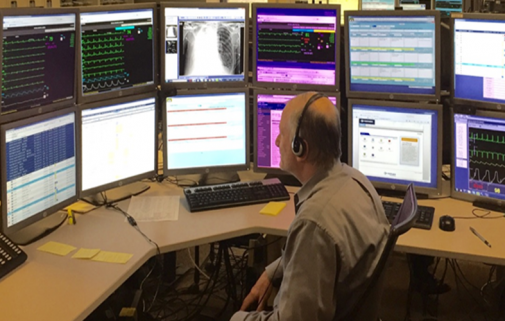An extra layer of life-saving care

Every year for the last 15 years, 26,000 critically ill patients admitted to Advocate Health Care’s intensive care units benefit from the system’s eICU command center. Lives have been saved and complications avoided because of the eICU’s highly sensitive telemedicine technology and the 24/7 team of experienced, board-certified, critical care physicians and nurses who monitor every patient in Advocate’s 320 ICU beds, plus an additional 104 outreach ICU patients as far away as Delaware.
Located in Oak Brook, Ill., the eICU command center uses computers, secure cameras and encrypted, high-speed data lines to remotely monitor patients’ vital signs, lab results and more. If a change is noted or a concern identified, the eICU doctors and nurses – in collaboration with the patient’s bedside doctor – coordinate a course of treatment to improve outcomes for these very complex and ill patients.
Dr. Michael Ries, medical director of Adult Critical Care and eICU, and Cindy Welsh, vice president of Adult Critical Care and eICU, answer a few questions about the program. (eICU® is a registered trademark of Philips Healthcare and the name of the tele-ICU program that Advocate employs.)
Q: What was the main driver for the eICU program?
Dr. Michael Ries: The main driver for the eICU program is to improve outcomes for our patients. That means continuous innovation to reduce mortality and adverse events and to shorten the time a patient must spend in the ICU. It also means that because eICU technology can offload some of the work of the onsite physicians, these doctors can spend more time at patients’ bedsides and with their families.
Q: Can you discuss the impact the eICU has on care delivery? Does it shift resources away from the bedside?
Cindy Welsh: The program is not meant to replace bedside care providers but to add an extra layer of support and vigilance. Even small improvements can yield incredible results. Last year, Advocate eICU caretakers, in partnership with on-site care providers, saved 1,288 patients who – based on their APACHE score, a severity of illness tool that predicts their likelihood of survival when treatment begins – were not expected to go home alive.
Q: Can you help paint a picture of the eICU?
Cindy Welsh: The team works at computerized, electronic stations, each with 8-12 display monitors. They see the same things clinicians have access to at the bedside: real-time vital signs, x-rays, EKGs, the EMR documentation; but sometimes, they can see more subtle changes that are occurring and can alert a bedside caregiver of abnormalities before the patient decompensates.
Q: Were there any hurdles you had to overcome when getting the program off the ground?
Dr. Michael Ries: When the program first began, the idea of telemedicine was so new that the bedside physicians and nurses were unsure if their roles would change or how the patient care between the bedside and the remote eICU might be affected. We needed to demonstrate to the bedside clinicians how the technology could help them provide the best care for their patients and that we were their partners in that goal.
Q: When might a bedside clinician be likely to initiate contact?
Dr. Michael Ries: There are many situations when a bedside attending physician, nurse or resident will contact the eICU doctors and nurses, but some of the most common ones include:
- To discuss the transfer of care between shifts
- To assess new admissions
- To evaluate and treat acute issues such as dropping blood pressure, irregular heartbeats or breathing difficulties
- To interpret x-rays in real time at night
- When a resident physician calls the eICU to review a case or a problem
Q: How many people staff the eICU? And do clinicians actually like working there?
Cindy Welsh: Two to three physicians throughout the course of the day, and three at night, along with 9-10 nurses and 2-3 health care assistants. There are a few reasons why the clinicians like it. It’s challenging work, they have to think critically and they can impact a lot of patients. They enjoy teaching, and for many, the eICU can extend their careers by leveraging their critical thinking skills and experience. In some cases, the eICU nurses mentor “new to the ICU nurses” at the bedside, assisting them to gain a level of comfort in caring for critically ill patients.
Q: Is there any cost to patients?
Dr. Michael Ries: Advocate offers elCU care at no additional charge to patients. This extra layer of safety is built in to the high standards set for critical care at our hospitals. The Advocate Charitable Foundation’s donors have contributed $1.35M to support the program.
Related Posts
Comments
About the Author
Kelsey Sopchyk, health enews contributor, is a media relations coordinator at Advocate Health Care and Aurora Health Care. She earned her BA in journalism and mass communications from the University of Iowa. In her spare time, you can find Kelsey tending to her plant children, trying new sushi restaurants in Chicago and cheering on the Cubs.

















